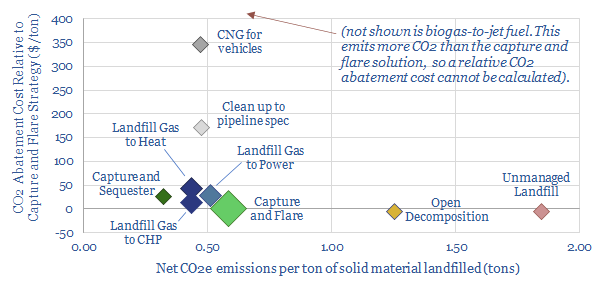Methane emissions from landfills account for 2% of global CO2e. c70% of these emissions could easily be abated for c$5/ton, simply by capturing and flaring the methane. Going further, low cost uses of landfill gas in heat and power can also make good sense. But vast subsidies for landfill gas upgrading, RNG vehicles and biogas-to-jet may not be cost-effective. Our 20-page note reviews the options.
Methane emissions from landfills are broken down on pages 2-5. We explain why they are generated, including the degradation pathways of different waste materials. We also review the typical sizes and end-markets for existing landfill gas capture programs.
Different options exist to capture and avoid these emissions. We have assessed ten options in this note, to quantify the potential market size. Our carbon accounting framework is summarized on page 6.
Different options are then reviewed in detail. In each case, we calculate the costs and discuss complexities. This includes methane capture and flaring (page 7), methane capture and sequestering (page 8), use of raw landfill gas in heat, power or CHP (pages 9-12), cleaning up to pipeline spec (pages 13-14), further cleaning into CNG transportation fuels (pages 15-16) and biogas-to-jet (page 17).
Perspective is crucial. The ultimate carbon abatement costs of landfill gas projects hinge on whether a project has served to reduce methane emissions. We are doubtful that some of the largest and most complex RNG projects will be genuinely incremental. They may simply offtake methane that was being captured anyway or could have been flared at vastly lower cost. This challenge is explored on pages 18-19.
Will subsidies stick? We debate this question on page 20, along with policy suggestions and conclusions for companies.
